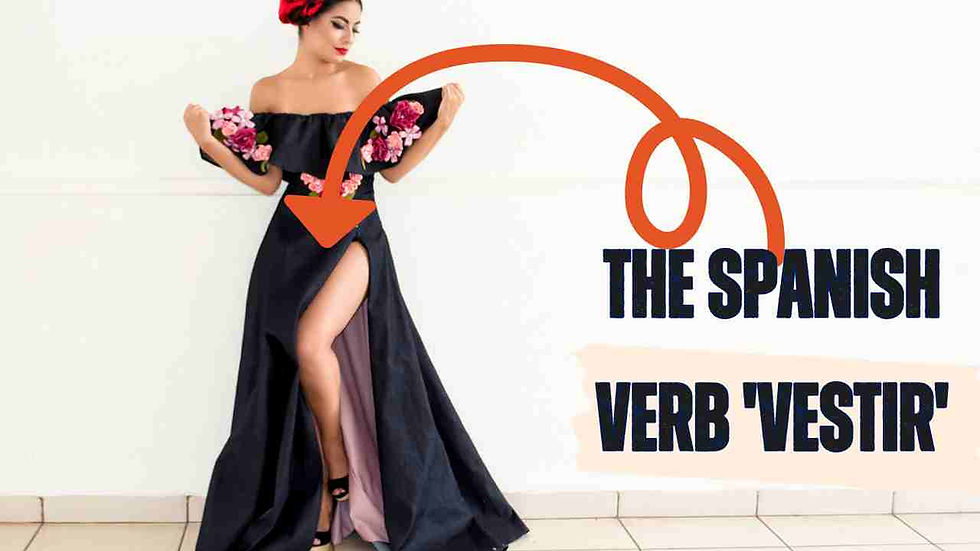The Art of Dressing Well: Embracing Diversity and Mastering the Spanish Verb "Vestir"
- Spanish Online Lessons

- Jan 19, 2024
- 2 min read
Welcome, fashion aficionados and Spanish learners! Today we're threading the needle between style and language by exploring the verb "vestir," an essential term in the rich tapestry of Spanish.

Respecting Diversity in Attire
Before we delve into linguistic intricacies, it's vital to acknowledge that dressing well doesn't conform to a single standard. Culture, religion, and personal beliefs weave diverse patterns of attire. Here, we celebrate all expressions of style, recognizing that dressing well means aligning with one's values and context.
Roots of "Vestir"
The verb "vestir" comes from the Latin "vestire," which means to clothe or to dress. It's related to the word "vestment," reflecting the importance of clothing in both daily life and ceremonial occasions.
Conjugation of "Vestir" Across Tenses
Let's dress up our Spanish grammar with the conjugation of "vestir":
Tense | Yo | Tú | Él/Ella/Usted | Nosotros/as | Vosotros/as | Ellos/Ellas/Ustedes |
Present | visto | vistes | viste | vestimos | vestís | visten |
Preterite | vestí | vestiste | vistió | vestimos | vestisteis | vistieron |
Imperfect | vestía | vestías | vestía | vestíamos | vestíais | vestían |
Future | vestiré | vestirás | vestirá | vestiremos | vestiréis | vestirán |
Conditional | vestiría | vestirías | vestiría | vestiríamos | vestiríais | vestirían |
Shopping for Clothes: A Dialogue
Imagine you're in a Spanish-speaking country, shopping for clothes. Here's how a conversation might unfold:
Customer: "Estoy buscando algo para vestir en una boda."(I'm looking for something to wear to a wedding.)
Seller: "Tenemos vestidos elegantes que podrían interesarle."(We have elegant dresses that might interest you.)
Customer: "¿Puede mostrarme algo en un estilo clásico?"(Can you show me something in a classic style?)
Seller: "Por supuesto, este modelo que está de moda realzaría su elegancia."(Of course, this fashionable model would enhance your elegance.)
Customer: "Me gusta. Voy a probármelo. ¿Dónde están los vestidores?"(I like it. I'm going to try it on. Where are the fitting rooms?)
Indirect Speech Example
Let's put on the indirect speech:
Direct: "¿Cómo me visto para la entrevista?"(How should I dress for the interview?)
Indirect: "Me preguntó cómo se debería vestir para la entrevista."(She asked me how she should dress for the interview.)
Idioms and Expressions
Spanish is rich with idiomatic expressions. Here's one with "vestir":
"Vestir a la moda" - "To dress fashionably"
And a proverb that reflects cultural wisdom:
"El hábito no hace al monje."
This saying reminds us that what one wears does not define who they are, reinforcing the message that dressing well is subjective and personal.
Dressing well in Spanish goes beyond "vestir bien." It's an expression of identity and respect for one's self and culture. As you navigate both the world of fashion and Spanish, remember that Spanish Super Tutor is your go-to resource for learning every day. Our doors are open for lessons that fit your style, and you can reserve your spot right here.
And for those up for a challenge, join our Spanish Squid Game! It's a community-driven journey filled with tasks, games, and challenges designed to enhance your Spanish in the most engaging way. Enrollment is open, and you can sign up here to start weaving Spanish into your life's fabric. Let's dress up your language skills together!
















Comments